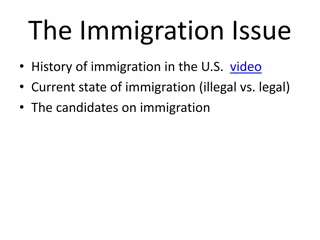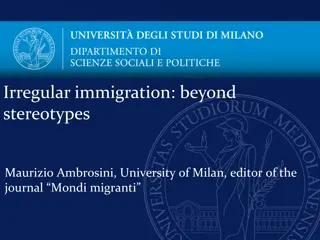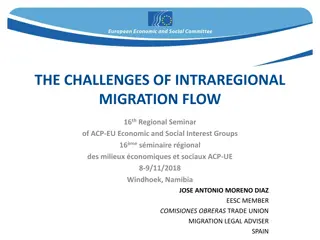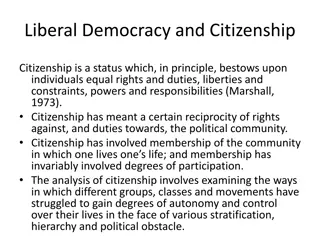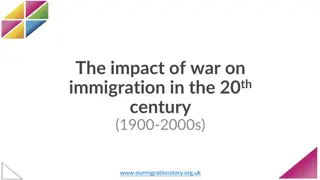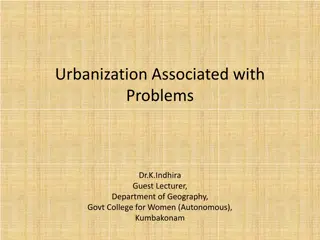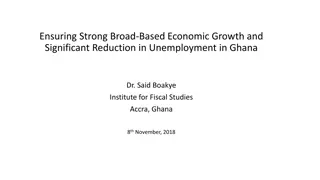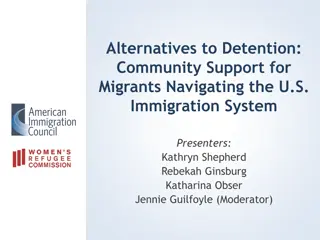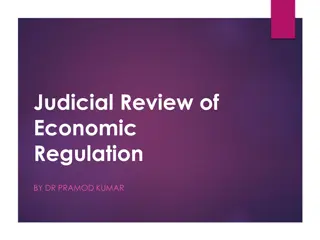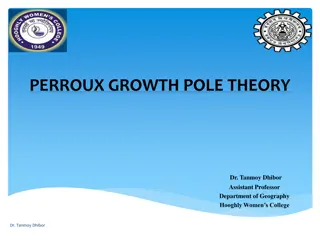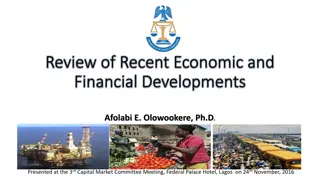Canada's Immigration Policy: An Analysis of Economic Growth and Political Considerations
Canada's immigration policy since the early 1990s has focused on adding over 225,000 newcomers annually to address economic needs and counteract aging demographics. While the economic benefits are emphasized, there are insights into the political motivations behind increasing immigration levels. This analysis raises questions about the long-term implications and the need for a cost-benefit assessment.
Download Presentation

Please find below an Image/Link to download the presentation.
The content on the website is provided AS IS for your information and personal use only. It may not be sold, licensed, or shared on other websites without obtaining consent from the author. Download presentation by click this link. If you encounter any issues during the download, it is possible that the publisher has removed the file from their server.
E N D
Presentation Transcript
Canadas Immigration Policy: Where is it taking us? The Need for a Cost Benefit Analysis Madeline Weld Population Institute Canada Presentation to POGG, Ottawa, Ontario January 18, 2014
What were doing Since the early 1990s, Canada has been adding 225,000 or more newcomers each year In 2010,the intake was > 550,000 (280,000 permanent residents, 182,000 temporary foreign workers, and 96,000 students) Canada s population grows by ~ 1%/year = doubling time of 70 years
Why we say were doing it Economic growth is essential to well-being and population growth drives economic growth The labour force would stop growing without immigration We need skilled immigrants for actual or looming labour shortages Our population is aging rapidly We need immigrants for our economically depressed areas
Why were really doing it McDougall wins battle to increase immigration Minister sees new source of voters for Conservatives HUGH WINSOR. The Globe and Mail. Toronto, Ont.: Oct 24, 1990. pg. A.1
Immigration Minister Barbara McDougall has won a major cabinet battle by convincing her colleagues that increased immigration will be good for Canada economically and provide the Conservatives with a new source of voters, sources say. Despite concerns about the social and financial impact of increased immigration and doubts about the country s ability to assimilate new arrivals at the current rate, Ms McDougall will announce tomorrow that Canada will begin accepting up to 250,000 immigrants a year. Globe and Mail, October 24, 1990
And we know the rest of the story. Prime Minister Brian Mulroney s policy of mass immigration regardless of economic conditions was pursued by all his successors. And mass immigration is supported by national political parties that have not governed federally, the NDP and the Green Party. So it must be a great and well thought out policy, right?
US Commission on Population and the American Future, 1972 "We have looked for, and have not found, any convincing argument for continued national population growth. The health of our economy does not depend on it. The vitality of business does not depend on it. The welfare of the average person does not depend on it."
Science Council of Canada Report No. 25, Population, Technology and Resources , 1976 The Report draws attention to the way a rapidly growing population would exacerbate the stresses caused by existing patterns of production and consumption. It notes the probability of greatly increased pressures on Canada s urban areas, transportation systems and related social and political institutions. Uncertainty about the extent of non-renewable especially energy resources is noted, and the potentially adverse effects of climatic fluctuation on Canada s renewable resource base is considered.
Intelligence Advisory Committee confidential report to the Privy Council, 1991 Controlling population growth is crucial to addressing most environmental problems, including global warming. It is, because of its harsh climate and long distances, the most energy-intensive of the free-market industrialized nations. Canada is endowed with vast water resources, but with 90 percent of its population concentrated within a band up to 100 miles of the USA border, water resources in these areas are already being utilized to their fullest. Polluted water has become an everyday concern.
Intelligence Advisory Committee confidential report to the Privy Council (cont d) Although Canada s population is not large in world terms, its concentration in various areas has already put stress upon regional environments in many ways. Canada can expect to have increasing numbers of environmental refugees requesting immigration to Canada, while regional movements of the population at home, as from idle fishing areas, will add further to population stresses within the country.
But hasnt a growing population benefitted Canada economically? Statistics Canada 2006 Census: The median earnings of Canadians (in constant 2005 $) increased by 0.1% between 1980 and 2005 (i.e., ~nil). The earnings of the poorest quintile fell by 20.6%. The earnings of the richest quintile rose by 16.4%. All population growth did is redistribute the wealth to the rich (who own the growth-promoting media).
Economic benefits of Canadas population growth (cont d) Less than 20% of immigrants are selected on the basis of skills. The remainder are nuclear family members or fall under the family re-unification category (e.g., parents) or other categories. In recent decades, the earnings of recent immigrants have fallen far behind those of native-born Canadians or more established immigrants. An economic study calculated that recent immigrants receive $18 23 billion more in government assistance (e.g., language and skills training, welfare) than they pay in taxes. (H. Grubel & P. Grady, 2011, Immigration and the Canadian Welfare State)
Economic benefits of Canadas population growth (cont d) Number 1 destination is Toronto. If mass immigration is so good for the economy, why did Ontario change from a donor to a recipient of federal equalization payments? Ontario has lost over 300,000 manufacturing jobs in the last decade; unemployment remains high; 16.5% among youth. Despite continued high unemployment, those labour shortages keep looming in the minds of politicians. Those who once made a living wage at places like Heinz, Kellogg's and Canada Post will be forced to compete with ever increasing numbers of New Canadians, who like them, will be lucky to cobble together part-time jobs at miserable wages just to get by. (Tim Murray, email 12 December 2013)
Canada Manufacturing Jobs: Sales Are Back, But 200,000 Jobs Are Missing Rachel Mendleson, Huffington Post 02/17/2012 http://www.huffingtonpost.ca/2012/02/17/canada-manufacturing-sales-jobs-missing_n_1283505.html
How about that aging population? All studies to date show that immigration has little impact on age structure of Canadians: S. Loh and M.V. George, 2007, Projected Population Size and Age Structure for Canada and Provinces: With and Without International Migration, Canadian Studies in Population, Vol. 34.2, 2007, pp. 103-127. R. Beaujot, 2003, Effect of Immigration on the Canadian Population: Replacement Migration? , Discussion Paper 03-03, Meeting of the Canadian Population Society, Halifax, NS, June 2003.
Aging population (contd) A C.D. Howe Institute study concluded that to keep the present dependency ratio (65+ versus workers) with the same age distribution of immigrants, there would need to be an immediate and colossal increase in the number of immigrants. By 2050, Canada s population would be 165 million and it would be taking in 7 million immigrants per year. C.D. Howe Institute No. 96, No Elixir of Youth: Immigration Cannot Keep Canada Young; September 2006.
Some facts that the growth boosters haven t considered Most of Canada is uninhabited for the same reason that Antarctica is: it isn t habitable. 75 80% of Canadians live along a 2785-mile long belt from Victoria, BC to Halifax, NS, and within 100 miles of the US border, on ~7.3% of Canada s land surface. Real population density is ~ 10 times higher than that obtained by dividing total surface area by population. 75% of immigrants go to Toronto, Vancouver, and Montreal; 90% settle in Canada s 12 largest metro areas. Most immigrants settle in Canada s big cities and leave its wide open spaces to the mosquitoes and black flies.
What growth boosters havent considered (cont d) The cities in the southern belt are as overstressed as big cities anywhere else in the world (especially Toronto, Vancouver, Montreal, Calgary, and Ottawa) If native born Canadians with historical and family ties can t make a living in economically depressed areas, should we expect immigrants with no such ties to do better?
UK House of Lords Select Committee on Economic Affairs In 2008, published a report called The Economic Impact of Immigration : Population growth through immigration does not translate into economic benefits The effect of immigration on the budget is broadly neutral in the long term, but large numbers add substantially to pressure on housing and government services
The economic arguments for growth are lies, damn lies, and not supported by statistics
Shilling for more growth: University of Toronto Public Policy professor Irvin Studin thinks Canada could better meet its potential and have more international clout with 100 million people (June 2010). Toronto Globe and Mail columnist Neil Reynolds says Canadians should Go forth, multiply, and fill the provinces (January 2011). He called overpopulation a Malthusian myth: the whole world would fit into Texas. Globe &Mail columnist Doug Saunders says a Canada of 100 million would be More comfortable, better served, better defended (May 2012)
Shilling for more growth (contd): The Globe and Mail had a growth-promoting series of articles in April to May, 2012. Some articles suggested that immigration levels should be doubled. The CBC, Canada s national broadcaster, relentlessly promotes the idea that immigration (growth) is key to Canada s economic well-being. These economic ideas are intertwined with the concept of multiculturalism as a vital, if not essential, component of Canada s identity.
We should send growthists to live in all those vast open spaces http://t1.gstatic.com/images?q=tbn:ANd9GcSwDtjRdJBUTiMzQhdEeE0GcFJ35JAabm8d5hnf-pLtwDge_9l6nQ
Cost of population growth: Farmland Only about 7% of Canada s surface area is in any way suitable for agriculture (classes 1 to 6), only classes 1, 2, and 3 are dependable as classified in the Canada Land Inventory (not hampered by severe constraints on crop production) 52% of Canada s best farmland (Class 1) is located in Ontario, most in the heavily urbanized southern part. Over 18 percent of Ontario s Class 1 farmland is now being used for urban purposes. (2001) (Statistics Canada 2001, Rural and Small Town Canada Analysis Bulletin Vol. 3, No. 2)
Cost of growth: Farmland (contd) By 2001, over 23,200 km2 of dependable farmland were lost to urban and rural settlement and 11,700 km2 lost to transportation and utilities Total permanent loss: 23,200 + 11,700 = 34,900 km2 Another 5,500 km2 lost to campgrounds, protected areas, and other uses from which it could be reclaimed The fruit belts in the Niagara peninsula and Okanagan Valley in British Columbia have lost farmland that was used to grow crops that cannot be grown anywhere else in Canada. (Statistics Canada 2005, Rural and Small Town Canada Analysis Bulletin Vol. 6, No. 1)
Cost of growth: Water An internal 2004 Environment Canada assessment for then Environment Minister St phane Dion chastises the federal government for failing to develop a water strategy, calls current approaches fragmented, short-term and inadequately informed, and includes the following information:
water shortages on the prairies caused $5 billion in economic damage in 2001 alone and threaten economic development in the West water shortages cause friction between provinces, between industries, and between Canada and the US our knowledge is sketchy in vital areas: we don t know how much ground-water we have, we don t understand the effects of newer pollutants such as pharmaceuticals flushed down drains or gender-bending pollutants that disrupt the sex hormone system in wildlife and humans in areas where we do understand the dangers, the information is scattered across different programs and provinces and is not nationally comparable the federal government should develop a national vision on water and take leadership on the issue (From Environment Canada assessment, 2004)
Cost of growth: Water (contd) groundwater drawn on by 10 million people is threatened by misuse and contamination from urbanization the ecosystem of the Great Lakes Basin, home to over 40 million North Americans, has been seriously degraded by urbanization 1997 report on a study of the Ecosystem Function of the Lower Fraser Basin concluded that the Fraser Valley is already in overshoot by a factor of three (led by Michael Healey of UBC)
Cost of growth: Urban living Time spent in traffic Noise, loss of greenspace, densification Health: Ontario Medical Association said in 2008 that air pollution causes 9500 premature deaths each year Houses: getting more or less affordable? Roads: getting better or worse? University education: getting more or less affordable?
http://t3.gstatic.com/images?q=tbn:ANd9GcTcTOsYWxxgJIxljTqIqsvb_pojSFzwYnPkGSphLl3VFUBF2DSCw1-fBNvjhttp://t3.gstatic.com/images?q=tbn:ANd9GcTcTOsYWxxgJIxljTqIqsvb_pojSFzwYnPkGSphLl3VFUBF2DSCw1-fBNvj http://t3.gstatic.com/images?q=tbn:ANd9GcSqkDdcW0N3_Uzq5lGFGZ3EzA_23wtysXy-ZzBjW-plEdR5p1bJ-g
Cost of growth: Infrastructure An increasing population requires more office buildings, schools, malls, roads, services Jane O Sullivan of Queensland Univ., Australia: infrastructure on average lasts 50 years, i.e. about 2% on average needs to be replaced annually If population grows at 2% annually, need to grow infrastructure 2% annually = double that of replacement with stable population Useful life of infrastructure also reduced by growth outstripping its capacity
Cost of growth: Infrastructure (contd) MIT economist Lester Thurow estimated that it requires 12.5 per cent of GDP to expand capacity at 1 per cent per year. For the developed world this was over $200,000 per person of net population growth Ottawa area infrastructure problems, including fatal accidents and near misses: exploding boilers, car-swallowing sinkholes, lots of broken watermains, proliferating potholes .
Cost of growth: Biodiversity (contd) From www.thepetitionsite sponsored by Nature Conservancy of Canada: In the southern band of Canada where 90% of us live, 85% of our terrestrial species are battling for their lives, trying to co-exist with us on dwindling fragments of our natural land. Don t let the swift fox and other Canadian species disappear! [The swift fox was extirpated in Canada by the 1930s but in 1983 captive-bred swift foxes were released in the prairies and now has Endangered status in Canada.]
Cost of growth: Biodiversity (contd) There are now 701 wildlife species in various COSEWIC risk categories, including 302 Endangered, 166 Threatened, 196 Special Concern, and 22 Extirpated (i.e. no longer found in the wild in Canada). In addition to these wildlife species that are in COSEWIC risk categories, there are 15 wildlife species that are Extinct. Committee on the Status of Endangered Wildlife in Canada http://www.cosewic.gc.ca/rpts/Full_List_Species.htm Accessed 11 January 2014
Cost of growth: Biodiversity (contd) Over two-thirds of southern Ontario's wetlands have disappeared during the last 200 years, mostly drained for agriculture or filled in for development. (http://www.on.ec.gc.ca/wildlife/factsheets/fs_coastal_wetlands-e.html) Conversion of lands to agriculture in the prairies has resulted in the loss of 87% of the native shortgrass prairie habitat, 81% of the native mixed grass prairie habitat, almost all the native tallgrass prairie habitat, and 84% of the native aspen parkland habitat. (http://redpath-museum.mcgill.ca/Qbp/3.Conservation/impacts.htm#2.1)
Cost of growth: Biodiversity (contd) Bye, bye birdie? Since 1967 the average population of the common birds in steepest decline has fallen by 68 percent; some individual species nose-dived as much as 80 percent. All 20 birds on the national Common Birds in Decline list lost at least half their populations in just four decades. Audubon Society http://birds.audubon.org/common-birds-decline Accessed 11 January 2014 Human activity also affects wildlife in less densely populated areas, e.g., drilling for oil, pipelines, pollution Colony collapse disorder of honey bees is probably driven by human activity, e.g., through wide use of pesticides
Cost benefit analysis of mass immigration: Measurements accepted by mainstream economists show no net economic benefit They do show a large redistribution of wealth from poor to rich Mainstream economists believe that there CAN be infinite growth on a finite planet and that there are substitutes for everything Economists view human beings as one- dimensional consumers
Cost benefit analysis (contd): Mainstream economists don t assign any cost to: The loss of natural capital that we got for free and which is irreplaceable: farmland, fertile soil, non-polluted air and water, biodiversity Declining quality of life from loss of natural habitat and greenspace, air quality, noise, amount of time spend commuting . Cultural conflicts and social fragmentation due to insufficient assimilation
Cost benefit analysis of mass immigration: What benefits? What costs? Policy driven not so much by what are the benefits? as Who benefits? Benefits go the few, costs are shared by all Examples of beneficiaries of growth: bankers (more mortgages), developers, business that can use cheap labour Tim Horton s and McDonald s restaurants were 2 of top 3 users of Temporary Foreign Workers
The beneficiaries of growth have more power and influence than most people and more access to the media to support their message: Growth is good, growth is great, growth is the solution to every problem (even the ones it creates) Cheap labour, mass immigration, open borders etc. serve corporate interests but not the interests of most people and certainly not any non-human life forms (except for our colonic microflora and mosquitoes) We must come out from under the thrall of the economic priesthood that promotes the doctrine of Holy Growth The God of Growth is a false god.
Growth cant go on forever on a finite planet, or in a finite country. Growth and human activities are having an impact on Canada s resources: cod fishery, salmon fisheries, boreal forest devastated by western pine beetle https://encrypted-tbn3.gstatic.com/images?q=tbn:ANd9GcRmTdpLngdvY93JwHyPr8eZ5vnCb7GreC-ZtYoIv5lKGy5hAwDy
Impact of growth examined in Beaver Fever: Special Canada issue of The Social Contract (Spring 2013)




